Pressemeddelelse
Measuring the Size of a Small, Frost World
Stellar occultation allows VLT to determine Charon's size and to put upper limit on its atmosphere
4. januar 2006
Observing a very rare occultation of a star by Pluto's satellite Charon from three different sites, including Paranal, home of the VLT, astronomers were able to determine with great accuracy the radius and density of the satellite to the farthest planet. The density, 1.71 that of water, is indicative of an icy body with about slightly more than half of rocks. The observations also put strong constraints on the existence of an atmosphere around Charon.
Since its discovery in 1978, Charon and Pluto have appeared to form a double planet, rather than a planet-satellite couple. Actually, Charon is about twice as small as Pluto in size, and about eight times less massive. However, there have been considerable discussions concerning the precise radii of Pluto and Charon, as well as about the presence of a tenuous atmosphere around Charon.
In August 2004, Australian amateur astronomer Dave Herald predicted that the 15-magnitude star UCAC2 26257135 should be occulted by Charon on 11 July 2005. The occultation would be observable from some parts of South America, including Cerro Paranal, in the northern Atacama Desert, the location of ESO's Very Large Telescope (VLT).
Stellar occultations have proved to be powerful tools to both measure sizes - at km-level accuracy, i.e. a factor ten better than what is feasible with other techniques - and detect very tenuous atmosphere - at microbar levels or less. Unfortunately, in the case of Charon, such occultations are extremely rare, owing to the very small angular diameter of the satellite on the sky: 55 milli-arcsec, i.e. the size of a one Euro coin observed from 100 km away!
This explains why only one occultation by Charon was ever observed before 2005, namely on 7 April 1980 by Alistair Walker, from the South Africa Astronomical Observatory.
Similarly, only in 1985, 1988 and 2002 could astronomers observe stellar occultations by Pluto. Quite surprisingly, the 2002 event showed that Pluto's atmospheric pressure had increased by a factor of two in four years (ESO Press Release eso0230).
"Several factors, however, have boosted our odds for witnessing occultations of Charon," said Bruno Sicardy, from Paris Observatory (France) and lead author of the paper reporting the results. "First, larger telescopes now give access to fainter stars, thus multiplying the candidates for occultations. Secondly, stellar catalogues have become much more precise, allowing us to do better predictions. And, finally, the Pluto-Charon system is presently crossing the Milky Way, thereby increasing the likelihood of an occultation."
The July 2005 event was eventually observed from Paranal with Yepun, the fourth Unit Telescope of the VLT, equipped with the adaptive optics instrument NACO, as well as with the 0.5m "Campo Catino Austral Telescope" at San Pedro de Atacama (Chile), and with the 2.15m "Jorge Sahade" telescope at Cerro El Leoncito (Argentina).
An accurate timing of the occultation seen at the three sites provides the most accurate measurement of Charon's size: its radius is found to be 603.6 km, with an error of the order of 5 km.
This accuracy now allows astronomers to pin Charon's density down to 1.71 that of water, indicative of an icy body with about slightly more than half of rocks. Quite remarkably, Charon's density is now measured with much more precision than Pluto's.
Thanks to these observations, Sicardy and his collaborators could determine that if an tenuous atmosphere exists on Charon, linking it to the freezing ‑220 degrees centigrade or so surface, its pressure has to be less than one tenth of a millionth that at the surface of the Earth, or 0.1 microbar, assuming that it is constituted entirely of nitrogen.
A similar upper limit is derived for a gas like carbon monoxide. This is more than a factor one hundred smaller than Pluto's surface pressure, which is estimated to be in the range 10-15 microbars.
"Comparing Pluto and Charon, we seem to cross a borderline between bodies which may have bound atmospheres - like Pluto - and airless bodies like Charon", said Olivier Hainaut, from ESO and member of the team.
The observations also indicate that methane ice, if present, should be restricted to very cold regions of the surface. Similarly, nitrogen ice would be confined at best to high northern latitudes or permanently shadowed regions of Charon.
As Pluto and its satellite sweep across the Milky Way, observations of more occultations will be tempted from the ground, while the NASA's Pluto-Kuiper Belt Mission, to be launched in January 2006, will be travelling towards the planet, that it should reach in July 2015.
A report of these results is to be published in the January 5, 2006 issue of Nature ("Charon's size and upper limit on its atmosphere from a stellar occultation", by B. Sicardy, A. Bellucci, E. Gendron, F. Lacombe, S. Lacour, J. Lecacheux, E. Lellouch, S. Renner, S. Pau, F. Roques, T. Widemann, F. Colas, F. Vachier, N. Ageorges, O. Hainaut, O. Marco, W. Beisker, E. Hummel, C. Feinstein, H. Levato, A. Maury, E. Frappa, B. Gaillard, M. Lavayssière, M. Di Sora, F. Mallia, G. Masi, R. Behrend, F. Carrier, O. Mousis, P. Rousselot, A. Alvarez-Candal, D. Lazzaro, C. Veiga, A.H. Andrei, M. Assafin, D.N. da Silva Neto, R. Vieira Martins, C. Jacques, E. Pimentel, D. Weaver, J.-F Lecampion, F. Doncel, T. Momiyama, and G. Tancredi).
High resolution images and their captions are available on this page.
Kontakter
Bruno Sicardy
Paris Observatory
Paris, France
Tel: +33-(0)6-19 41 26 15
E-mail: Bruno.Sicardy@obspm.fr
Olivier Hainaut
ESO
Germany
Tel: +56 55 43 5336
Mobil: +56 2 463 3118
E-mail: ohainaut@eso.org
Om pressemeddelelsen
| Pressemeddelelse nr.: | eso0602 |
| Legacy ID: | PR 02/06 |
| Navn: | Charon, Pluto |
| Type: | Solar System : Planet : Satellite Solar System : Interplanetary Body : Dwarf planet |
| Facility: | Very Large Telescope |
| Instruments: | NACO |
| Science data: | 2006Natur.439...52S |
Our use of Cookies
We use cookies that are essential for accessing our websites and using our services. We also use cookies to analyse, measure and improve our websites’ performance, to enable content sharing via social media and to display media content hosted on third-party platforms.
ESO Cookies Policy
The European Organisation for Astronomical Research in the Southern Hemisphere (ESO) is the pre-eminent intergovernmental science and technology organisation in astronomy. It carries out an ambitious programme focused on the design, construction and operation of powerful ground-based observing facilities for astronomy.
This Cookies Policy is intended to provide clarity by outlining the cookies used on the ESO public websites, their functions, the options you have for controlling them, and the ways you can contact us for additional details.
What are cookies?
Cookies are small pieces of data stored on your device by websites you visit. They serve various purposes, such as remembering login credentials and preferences and enhance your browsing experience.
Categories of cookies we use
Essential cookies (always active): These cookies are strictly necessary for the proper functioning of our website. Without these cookies, the website cannot operate correctly, and certain services, such as logging in or accessing secure areas, may not be available; because they are essential for the website’s operation, they cannot be disabled.
Functional Cookies: These cookies enhance your browsing experience by enabling additional features and personalization, such as remembering your preferences and settings. While not strictly necessary for the website to function, they improve usability and convenience; these cookies are only placed if you provide your consent.
Analytics cookies: These cookies collect information about how visitors interact with our website, such as which pages are visited most often and how users navigate the site. This data helps us improve website performance, optimize content, and enhance the user experience; these cookies are only placed if you provide your consent. We use the following analytics cookies.
Matomo Cookies:
This website uses Matomo (formerly Piwik), an open source software which enables the statistical analysis of website visits. Matomo uses cookies (text files) which are saved on your computer and which allow us to analyze how you use our website. The website user information generated by the cookies will only be saved on the servers of our IT Department. We use this information to analyze www.eso.org visits and to prepare reports on website activities. These data will not be disclosed to third parties.
On behalf of ESO, Matomo will use this information for the purpose of evaluating your use of the website, compiling reports on website activity and providing other services relating to website activity and internet usage.
Matomo cookies settings:
Additional Third-party cookies on ESO websites: some of our pages display content from external providers, e.g. YouTube.
Such third-party services are outside of ESO control and may, at any time, change their terms of service, use of cookies, etc.
YouTube: Some videos on the ESO website are embedded from ESO’s official YouTube channel. We have enabled YouTube’s privacy-enhanced mode, meaning that no cookies are set unless the user actively clicks on the video to play it. Additionally, in this mode, YouTube does not store any personally identifiable cookie data for embedded video playbacks. For more details, please refer to YouTube’s embedding videos information page.
Cookies can also be classified based on the following elements.
Regarding the domain, there are:
- First-party cookies, set by the website you are currently visiting. They are stored by the same domain that you are browsing and are used to enhance your experience on that site;
- Third-party cookies, set by a domain other than the one you are currently visiting.
As for their duration, cookies can be:
- Browser-session cookies, which are deleted when the user closes the browser;
- Stored cookies, which stay on the user's device for a predetermined period of time.
How to manage cookies
Cookie settings: You can modify your cookie choices for the ESO webpages at any time by clicking on the link Cookie settings at the bottom of any page.
In your browser: If you wish to delete cookies or instruct your browser to delete or block cookies by default, please visit the help pages of your browser:
Please be aware that if you delete or decline cookies, certain functionalities of our website may be not be available and your browsing experience may be affected.
You can set most browsers to prevent any cookies being placed on your device, but you may then have to manually adjust some preferences every time you visit a site/page. And some services and functionalities may not work properly at all (e.g. profile logging-in, shop check out).
Updates to the ESO Cookies Policy
The ESO Cookies Policy may be subject to future updates, which will be made available on this page.
Additional information
For any queries related to cookies, please contact: pdprATesoDOTorg.
As ESO public webpages are managed by our Department of Communication, your questions will be dealt with the support of the said Department.



